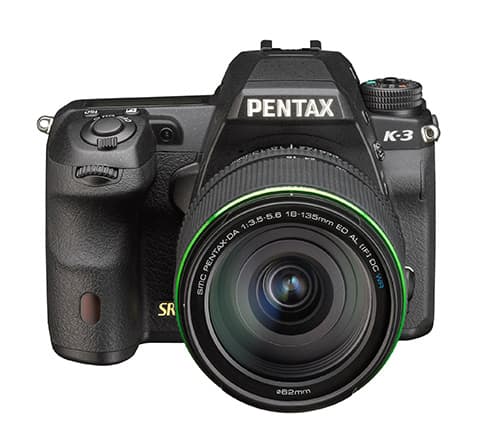[Update includes revision of prices, following figures supplied to AP in original interview]
Due out on November, priced £1,099.99 body only, the K-3 is billed as a ‘significant upgrade’ and squarely aimed at dedicated enthusiasts and semi-professional photographers.
The K-3 features a new 24-million-pixel, Sony-made, APS-C sized CMOS imaging sensor and a revamped, 27-point (25 cross-type sensors), Safox II AF system with a claimed minimum luminance of -3EV.
Pentax now has seven DSLRs, with the Pentax K-3 taking the K-flagship position, sitting above the ‘mid-class’ K-5II and K-5IIs in the range.
Armoury includes an 86,000-pixel RGB light metering sensor, a top ISO of 51,200 and a new, 14-bit A/D conversion, Prime Engine II image processor.

Boasting a ‘weather-resistant’ build – with 92 weather seals – the magnesium-alloy bodied K-3 contains a stainless-steel chassis and a dual SD card slot.
Firepower includes 8.5 frames per second shooting and a 3.2in 1.037k-dot screen – an area Pentax says has improved since it was taken over by Ricoh two years ago.
Ricoh Imaging UK managing director Jonathan Martin said that, in the past, the firm may have ‘let some of our users down’ with a lack of SLRs in its line-up.
In an interview with Amateur Photographer, he added: ‘The range has never expanded, but now…We are starting to be seen more as a player… Finally we have a serious range of products.’
Martin said Pentax cameras are now back in 11 reopened Jessops stores, with plans to be one in all 28 soon.
Anti-aliasing ‘simulator’ to combat
moiré
In a bid to boost image quality, by showing more detail, the K-3 does not have a low-pass filter on the camera’s imaging sensor.
However, this leaves the image vulnerable to moiré effects – such as those seen when photographing striped clothes, for example.
So, to help combat this, the K-3 features an anti-aliasing ‘simulator’ built into the camera’s shake-reduction (SR) system.
Billed as a ‘world first’, users can adjust the anti-aliasing filter effect level to suit the subject.
Ricoh Imaging says this ‘reduces the moiré effect by moving the SR unit at the sub-pixel level in a circular motion during image exposure’.
Microscopic vibrations are applied to the sensor to generate the ‘same level of moiré reduction effect as an optical anti-aliasing filter’.
The K-3 does not have built-in Wi-Fi but it will be compatible with an optional Flu Card.
This card is designed to enable remote control of the camera, wirelessly, using a smartphone up to 15 metres away – allowing the user to fire the shutter, alter focus points and enable the transfer of images to a mobile device where they can be viewed, for example.
The card, which is only compatible with the K-3 (it also accepts Eye-Fi cards) also serves as a traditional 16GB SD storage card.
A price and launch date of the Flucard (O-FC1) is yet to be confirmed.

Pentax will also next month debut a limited-edition ‘Premium Silver’ version of the K-3 (pictured above) of which only 2,000 have been made, with around 50 expected to reach UK shores (exact number to be confirmed).
‘Weather-resistant’ battery grip
Pentax is also set to launch its first weather-resistant battery grip, the AA-battery compatible D-BG5, plus a new 55-300mm f/4-5.8 ‘WR’ (£399) lens, featuring an HD coating, following calls from retailers.
The K-3 is made in the Philippines, like Pentax’s other DSLRs (the GR digital compact is made in Japan), and took one and a half years to develop.
When asked if Pentax DSLRs have been hit by the growth of compact system cameras in recent years, Martin replied: ‘What has held us back is lack of product…We are more alive and kicking than we were two years ago.’
Features brought into the Pentax brand by Ricoh include multi-pattern auto white balance and interval-composite multi-exposure.
K-3 kit options will include an outfit with an 18-55mm f/3.5-5.6 AL WR lens, priced £1,199.99.
The K-3 is the third Pentax DSLR since the 12 June, when the weather-resistant K-50 and entry-level K-500 were unveiled.









